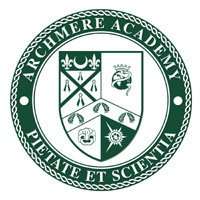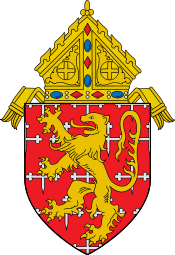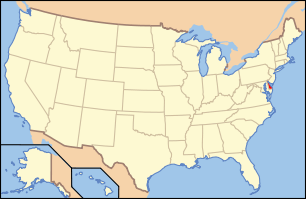Archmere Academy
| Archmere Academy 3600 Philadelphia Pike, Claymont, Delaware | |
|---|---|
|
Pietate et Scientia Faith and Knowledge | |
| Address | |
|
3600 Philadelphia Pike Claymont, Delaware, (New Castle County) 19703 United States | |
| Coordinates | 39°48′07″N 75°27′18″W / 39.80194°N 75.45500°WCoordinates: 39°48′07″N 75°27′18″W / 39.80194°N 75.45500°W |
| Information | |
| Type | Private, coeducational |
| Religious affiliation(s) | Roman Catholic |
| Denomination | Norbertine |
| Established | 1932 |
| Rector | Rev. Fr. Joseph McLaughlin, O. Praem |
| Principal | John Jordan '80 |
| Headmaster | Dr. Michael Marinelli '76 |
| Chaplain | Father John Zagarella |
| Grades | 9-12 |
| Enrollment | 505 (2015-2016) |
| Average class size | 15 |
| Student to teacher ratio | 6:1 |
| Color(s) | Green and White |
| Mascot | Great Auk |
| Nickname | Auks |
| Accreditation | Middle States Association of Colleges and Schools[1] |
| Publication | Tapestry |
| Newspaper | The Green Arch |
| Yearbook | The Patio |
| Director of Student Life | Robert Nowaczyk |
| Director of Admissions | Kristin Mumford |
| Director of Finance | John Cirillo III |
| Director of Institutional Advancement | Rebecca Baeurle |
| Director of Athletics | David Oswinkle |
| Website |
www |
Archmere Academy is a private Roman Catholic college preparatory school based in Claymont, Delaware, United States. It enrolls approximately 500 students.[2] The academy is co-educational and is run independently within the Roman Catholic Diocese of Wilmington.
History
Archmere Academy was founded in 1932 by the Norbertine religious order, initially as an all-boys school.[3] It began on the former estate of U.S. industrialist John J. Raskob, who lived there with his wife Helena and their 12 children until 1931. Raskob was the campaign manager for New York Governor Al Smith during his presidential campaign in 1928 and the home was used for many meetings, including those of the Democratic National Committee.[4]

The estate was purchased by Bernard Pennings in 1932. He was the Abbot of the Norbertine Order and is attributed as the founder of St. Norbert College, a private Catholic liberal arts college located in De Pere, Wisconsin.[5] The estate was purchased for $300,000 in the spring of 1932 and officially dedicated in the fall of 1932.[3] The first year of operation, Archmere Academy had an enrollment of 22 students, 16 freshmen and 6 sophomores. In 1933 and 1934, enrollment grew to 50 students and 72 students respectively.[3]
Archmere Academy began slowly expanding during the mid to late 1930s due to enrollment increases. Minor expansions were made to accommodate boarding students. In 1939 it built its first gymnasium[6] and by 1940 it had converted the manor on the property into a science center. The school made a transition in the mid-1940s by where it became strictly a four-year college preparatory institution. It phased out both 7th and 8th grades during the 1946-47 and 1947-48 school years. It continued as a day school and boarding school for boys while its enrollment continued to increase.
In 1957, Archmere Academy celebrated its 25th anniversary with the groundbreaking for St. Norbert Hall, the school's main academic building, which was completed in 1959.[3] Going into the 1960s, it continued to expand to accommodate the increase in enrollment, which had reached 394 students by the end of that decade. The Justin E. Diny Science Center was opened in 1973 with classrooms for physics, chemistry, biology, and environmental science.[7] The old science center was turned into a center for the arts which held classes for the school's chorus, band, theater, and studio arts program.[7]
The 1970s brought about two major changes for Archmere Academy. It moved away from being a boarding school and became a day school exclusively.[2] In 1975 it also announced the decision to become a co-ed institution,[2] enrolling 50 women into the school. It was near the end of the 1970s that the academy established a Board of Trustees, the first meeting of which took place in 1980. The Board has been credited with expanding the curriculum and extracurricular activities at the academy as well as further expanding to accommodate the new programs. One expansion included a renovation of St. Norbert Hall which included an addition to the current building. Additional expansion in the early 1980s included a new auditorium that seated 750 people, as well as a new library constructed on campus.
In April 2001, an internal dispute among the Norbertines relating to the establishment of Claymont Priory separate from Daylesford Abbey spilled over into the administration of Archmere Academy. Interventions from alumni calmed the turmoil and resulted in the Academy taking control of the former Raskob residence, known as "the Patio."[8] 2003 marked the beginning of the academy's "Building on Mission & Heritage" campaign that included goals to complete the Justin E. Diny Science Center expansion, the construction of a Student Life Center, and renovations to the athletic field.
The school broke tradition in 2010 with the implementation of a non-Norbertine headmaster. Michael Marinelli, a 1976 graduate of Archmere Academy, took over at the beginning of 2010.[9]
Towards the end of the 2015-16 academic school year, Archmere began massive renovations on Saint Norbert Hall. This reconstruction made changes to the library and every room in the building.
Architecture
|
Archmere | |
|
The Patio, country estate of John J. Raskob | |
 | |
| Location | 3600 Philadelphia Pike, Claymont, Delaware |
|---|---|
| Coordinates | 39°48′08″N 75°27′13″W / 39.8023°N 75.4537°W |
| Area | 15 acres (6.1 ha) |
| Architect | Harper, Alexander James; McCure, Clay |
| Architectural style | Renaissance, Italian Renaissance |
| NRHP Reference # | 92001143[10] |
| Added to NRHP | September 9, 1992 |
Archmere Academy was built between 1916 and 1918 and was once the country estate of John J. Raskob and his wife. Raskob was a financier, the developer of the Empire State Building, and a previous chairman for the Democratic National Committee. The name "Archmere" was given to the estate because of the natural arch of the trees formed over the Delaware River vista. The original building that Raskob constructed, also known as the Patio, was placed on the National Register of Historic Places in 2007.[3] In 2009, the Delaware Public Archives dedicated Archmere Academy with a historical marker.[3]
Academics
Archmere students are required to take courses in a variety of areas, including eight semesters of English, as well as seven semesters of religion, and six semesters of mathematics, foreign language, history, and the sciences. Choices for elective classes include art, yearbook (which meets during class time), band, chorus, and computer courses.
Archmere offers a large number of AP courses, including Spanish, French, German, Statistics, Calculus, both AB and BC, Physics, Chemistry, Biology, Environmental Science, Art Portfolio in 2-D and 3-D, Computer Science, English, Composition, US History, European History, and World History.[9] It has been ranked high for overall student SAT scores, ranking 2nd in the state of Delaware for the 2011-12 school year.[11]
Music program
The music program at Archmere Academy is an elective program that focuses on performance practices from the Renaissance to the 20th century including jazz and Broadway. Instruction is provided mostly through rehearsal experience although there is also a course on music theory for advanced students as well as a songwriting course. Performing groups include the Concert Band, Concert Choir, Stage Band, and Mastersingers. The Mastersingers was founded in 1988 and consists of 21–25 students selected by audition at the beginning of the school year. In addition to giving community concerts, they compete nationally and internationally and supply music for school liturgies. The academy also has a partnership that allows student musicians to study with the Serafin String Quartet.[12]
Athletics
Archmere competes in the Diamond State Conference for interscholastic sports such as football, field hockey, basketball, ice hockey, soccer, swimming, diving, lacrosse, volleyball, golf, tennis, cheerleading, baseball, softball, cross country, track and field, and wrestling.
Archmere's campus features two artificial turf fields (utilized by football, M/W soccer, M/W lacrosse, and field hockey), a baseball field (upgraded with dugouts), a softball field (upgraded with dugouts), six tennis courts, and a running track.
In recent years, Archmere has brought home multiple DIAA championships, such as volleyball and rugby. The 2014 girls volleyball team brought home the trophy following a victory over Charter. In the following year, Archmere volleyball once again went to the finals, however this time losing to Delaware Military Academy. The rugby team at Archmere has brought home 2 consecutive Delaware state titles in 2015 and 2016.
Notable alumni

- Erin Arvedlund, author
- Joe Biden (class of 1961), Vice President of the United States, and six-term United States Senator from Delaware from 1973 to 2009[13]
- Joseph Robinette "Beau" Biden III (class of 1987), Delaware Attorney General[13]
- Thomas Capano, former deputy attorney general of Delaware who was convicted of the 1996 murder of Anne Marie Fahey
- Carly Ciarrocchi, television show host on the Sprout's The Sunny Side Up Show[14]
- Dominic Pileggi, politician from Pennsylvania who serves as Republican Leader of the Pennsylvania State Senate
- Mark T. Smith, painter
References
- ↑ MSA-CSS. "MSA-Commission on Secondary Schools". Archived from the original on February 12, 2011. Retrieved June 23, 2009.
- 1 2 3 "Archmere Academy". Delaware Today. Retrieved September 29, 2014.
- 1 2 3 4 5 6 "The Delaware Public Archives Dedicates Historical Marker at Archmere Academy". Claymont Renaissance News. Summer 2009.
- ↑ Johnson, Hugh S. "Wall Street Buys The New Deal". Reformation.org. Retrieved October 21, 2014.
- ↑ Barkan, Elliott Robert (2013). Immigrants in American History: Arrival, Adaptation, and Integration. ABC-CLIO. ISBN 9781598842197.
- ↑ "Delri League All Stars Divide Twin Bill on Cadet Court". Delaware County Daily Times. March 7, 1939. Retrieved October 21, 2014.
- 1 2 "Eager students await opening". Delaware County Daily Times. February 26, 1974. Retrieved October 21, 2014.
- ↑ Margot Patterson (May 11, 2001). "Turmoil follows school firings - Archmere Academy". National Catholic Reporter
- 1 2 Medoff, Theresa Gawlas (January 2010). "The Private School Primer". Delaware Today. Retrieved September 29, 2014.
- ↑ National Park Service (2010-07-09). "National Register Information System". National Register of Historic Places. National Park Service.
- ↑ Nardone, Mark (August 2014). "Classical Learning Style Yields Positive Test Results". Delaware Today. Retrieved September 29, 2014.
- ↑ Nardone, Mark (August 2014). "Serafin String Quartet Books Big-Time Fall Gigs". Delaware Today. Retrieved September 29, 2014.
- 1 2 Canton, Shannon (July 2003). "Family Business". Delaware Today. Retrieved September 29, 2014.
- ↑ Amis, Matt (May 2014). "Sunny Sides and Local Ties to Sprout". Delaware Today. Retrieved October 21, 2014.



